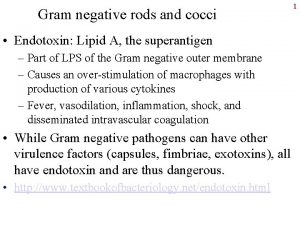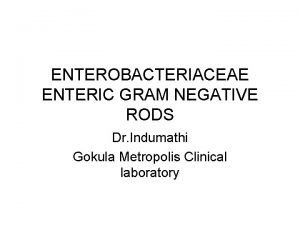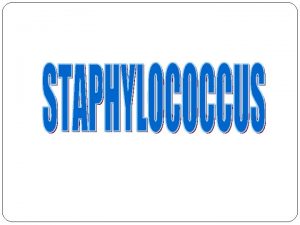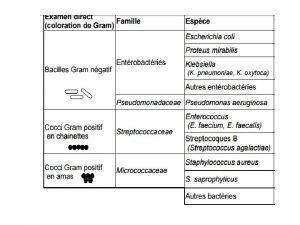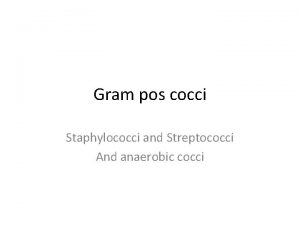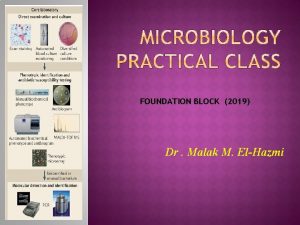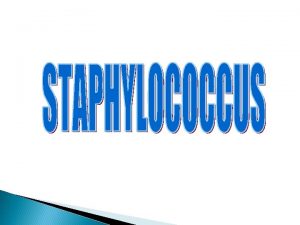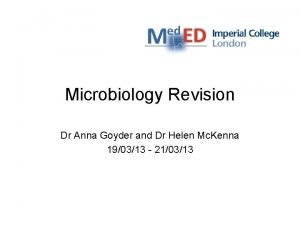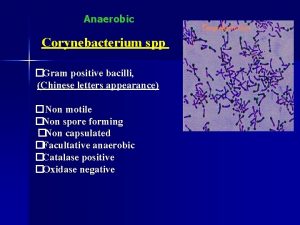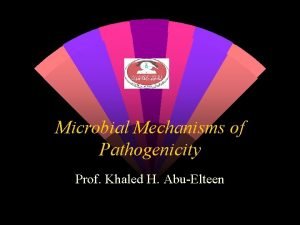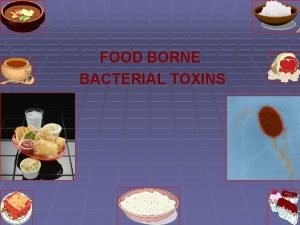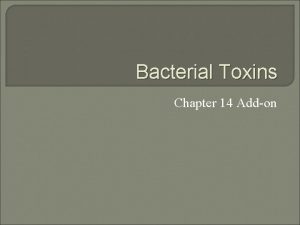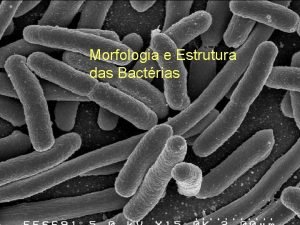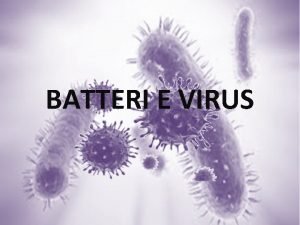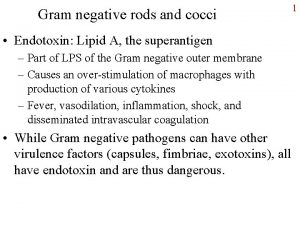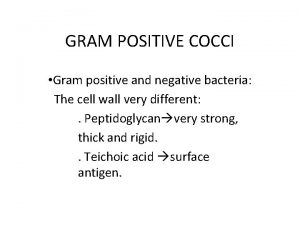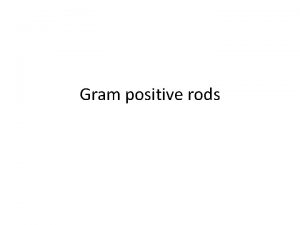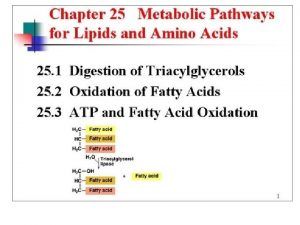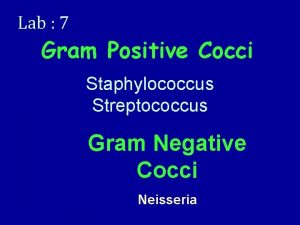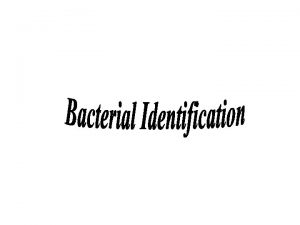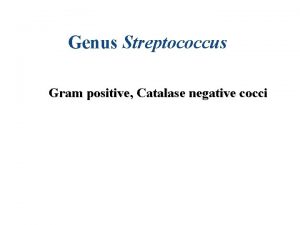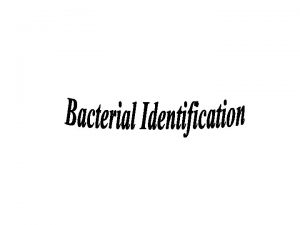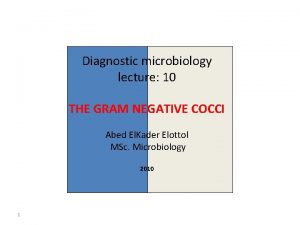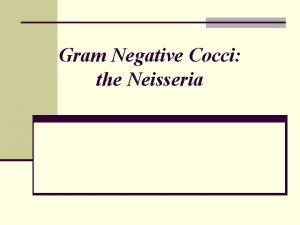Gram negative rods and cocci Endotoxin Lipid A



















- Slides: 19

Gram negative rods and cocci • Endotoxin: Lipid A, the superantigen – Part of LPS of the Gram negative outer membrane – Causes an over-stimulation of macrophages with production of various cytokines – Fever, vasodilation, inflammation, shock, and disseminated intravascular coagulation • While Gram negative pathogens can have other virulence factors (capsules, fimbriae, exotoxins), all have endotoxin and are thus dangerous. • http: //www. textbookofbacteriology. net/endotoxin. html 1

Neisseria: Gram negative cocci • Very few G- cocci – Some Neisseria, Branhamella are normal microbiota – Of greatest interest: these pathogenic ones • N. meningitidis and N. gonorrhoeae. – Delicate and fastidious; – oxidase +, coffee bean shaped in pairs – pyogenic www. microscopyconsulting. com/Gallery/pages /Neisseria%20 meningitidis. htm 2

N. gonorrhoeae • N. gonorrhoeae: cause of gonorrhea, STD 3 – Virulence factors: capsule, fimbriae, survival in neutrophils – Males: painful purulent discharge from urethra – Females: often asymptomatic; otherwise, urethritis, PID, infections anywhere sexual contact occurs, arthritis. – Eye infection of newborns, routine antibiotic treatment – No long term immunity! Pelvic inflammatory disease (PID): infection and inflammation of the upper genital tract in women. Affects the uterus, fallopian tubes, ovaries. Scarring can lead to infertility, tubal (ectopic) pregnancy, chronic pelvic pain, abscesses, and other serious problems. PID is the most common preventable cause of infertility in the United States.

Neisseria-2 • N. meningitidis: 1 cause of bacterial meningitis – Capsule protects cells during phagocytosis – Present as normal microbiota in 40% of population – Transmitted by droplets, close contact – Infection of meninges, sore throat, high fever, headache, stiff neck, vomiting, convulsions, petechiae; rapid. – Epidemiology: people living in close contact; military recruits currently vaccinated; because of outbreaks, push to vaccinate college students. 4

Enterobacteriaceae: Gram negative rods • Gram negative, small rods, facultatively anaerobic, oxidase negative; found in soil, water, and GI tracts – some strictly pathogens, others opportunists – Coliforms (ferment lactose) and non-coliforms • Virulence factors – Endotoxin, capsules, fimbriae, exotoxins, others. • Enteric bacteria identified by biochemical tests – Selective/differential media, IMVi. C tests, etc. – Strains identified by serological techniques 5

Serology and enteric bacteria • Because enteric bacteria are very closely related to each other, differentiation requires serology – Use of antibodies to identify particular antigenic molecules on cell surfaces – O antigen: repeating sugar group on LPS – H antigen: flagellar protein – K antigen: capsule antigen around cell. – Example: E. coli O 157: H 7 describes particular serotype which happens to also produce a dangerous exotoxin. 6

7 http: //www. ratsteachmicro. com/Assets/Enterobacteriaceae/Enterobact_diagram 2. gif

E. coli: friend or foe? 8 • E. coli: cause of 90% of urinary tract infections – Most strains common to GI tract, not harmful there. – Strains have fimbriae needed for attachment – Proanthocyanidins in cranberry juice interfere • E. coli: common cause of diarrhea – Many strains possess genes (some on plasmids) that code for additional virulence factors like exotoxins which cause disease • E. coli O 157: H 7: possesses shiga toxin; strain causes hemolytic uremia syndrome, damages kidneys. • E coli strains classified as EHEC, EIEC, EPEC, etc. – Enterohemorrhagic, enteroinvasive, etc.

Some Opportunistic enterics • • • Klebsiella Proteus Enterobacter Citrobacter Providencia Yersinia Morganella Edwardsiella Serratia http: //microvet. arizona. edu/Courses/MIC 4 21 B/Secure/Lecture%205%20 online. ppt#1 Nice looking powerpoint on Enteric bacteria with fill-in points for self-quizzing. Copy and paste. 9

Truly pathogenic enterics 10 • Salmonella: species so closely related that they are really all S. enterica. But medically, species epithets still used: S. typhi and others. Divided serologically. – Present in eggs, poultry, on animals such as reptiles – Large dose results in food poisoning; diarrhea, fever, etc. – Cells phagocytized by intestinal lining cells, kill cells causing symptoms, may pass through into blood. – S. typhi: typhoid fever. Spread through body • Gall bladder as reservoir; Typhoid Mary – http: //www. pbs. org/wgbh/nova/typhoid/ • Importance of clean water and sewage treatment.

Truly pathogenic enterics-2 11 • Shigella: especially S. sonnei (most common) and S. dysenteriae (most serious); cause shigellosis. – Food, flies, fingers, feces, fomites: very small infectious dose, personal hygiene important in prevention. – Infection of intestinal lining damaged, cells pass directly from cell to cell; cramps, diarrhea, bloody stools. – S. dysenteriae produces shiga toxin which inhibits protein synthesis, increases damage. – Most serious problem with diarrheal diseases in general is dehydration.

Truly pathogenic enterics-3 12 • Yersinia: Y pestis is cause of plague, other species cause food-borne infections • Plague: 3 cycles: sylvan, urban, and human – endemic in sylvan cycle; mixing of woodland urban rodents brings urban cycle, fleas jump from dying rats to humans. – Infection leads to large swollen lymph nodes: buboes • Bubonic plague, with high fever. • Septicemic plague: with DIC, bruising (black death) – Raises mortality from 75% to near 100% • Pneumonic: coughed out and spread human to human – 100% mortality

The S. F. earthquake and plague http: //library. thinkquest. org/03 oct/00904/images/sanf. jpg http: //www. cdc. gov/ncidod/dvbid/plague/plagwest. htm 13

Pasteurellaceae: small G- rods • Generally fastidious • Pasteurella: mostly P. multocida – Common in animals; people get by bites, scratches – Inflammation, swollen nodes near site if infection • Haemophilus: H. influenzae – H. influenzae: mostly respiratory infections and meningitis and epiglottitis in very young. – Carried as normal microbiota by many – Capsule is major virulence factor; Hib vaccine protects • H. ducreyi: STD chancroid; not common. 14

Gram negative aerobic rods • Brucella: different species for each animal – Infection from contact with livestock, fluids e. g. dairy – Undulant fever: fever that goes up and down; several other names including Bang’s disease, Brucellosis. – Largely controlled in US cattle, not bison. • Bordetella: B. pertussis, cause of whooping cough – Infects trachea, several toxins. – Disease in stages: incubation, catarrhal, paroxysmal • Coughing and inhalation: whoop – DPT, but now new acellular vaccine due to publicity – B. broncispetica, common cause of kennel cough 15

Pseudomonas: G- aerobic rod • Pseudomonas and relatives very common • P. aeruginosa the most dangerous; opportunist – Endotoxin, exotoxins, fimbriae, enzymes, capsule – Capable of causing disease anywhere in body – Two major problems: burn patients and cystic fibrosis • Cause of swimmer’s ear, hot tub infections, etc. – Resistant to most disinfectants and antibiotics http: //www. wasserwissen. de/abwasserl exikon/p/images/pse udomonas. gif http: //www. readingfordummies. com/blog/archives/USPhotos/2005 -01 -12/01 -Hot. Tub. jpg 16

Other Gram - rods • Francisella: F. tularensis, cause of tularemia – Also called rabbit fever, tick fever, deerfly fever, etc. – Most cases in US in Arkansas/Missouri Ozarks – Survives phagocytosis, lives intracellularly – Present in many animals, transferred to humans by vector, ingestion, direct contact, inhalation – Chills, fever, malaise, swollen nodes http: //er 1. org/docs/photos/Tularemia/ Amblyomma%20 Americanum%20(lo ne%20 star%20 tick). jpg http: //mercury. bio. uaf. edu/~g eorge_happ/Francisella. jpg 17

Other Gram – rods-2 18 • Legionella: L. pneumophila and several others – Fastidious in culture, requires special media – Very common in aquatic environments: ponds, cooling towers, hotwater heaters, showers. – Grows normally in amoebae, so also grows in phagocytes – Most dangerous as opportunistic pneumonia, inhalation – Mild form of disease: ‘pontiac fever’ www. angelfire. com/retro 2/lisawebworld/bi

Anaerobic Gram - rods 19 • Anaerobic sites and infections – Many different anaerobic bacteria live in parts of body, esp. GI tract (>99% anaerobes) but also in mouth, genitourinary tract. – Trauma to these areas leads to polymicrobic infections. – These are opportunists, cause abscesses in GI tract, reproductive tract, and cause wound infections • Bacteroides – One of most common bacteria in GI tract • Fusobacterium – Found more in oral cavity, also in GI
 Example of gram negative cocci
Example of gram negative cocci Rods or cocci
Rods or cocci Enteric gram negative rods
Enteric gram negative rods Gram positive cocci
Gram positive cocci Cocci gram negatif
Cocci gram negatif Mannitol fermentation
Mannitol fermentation Erythrogenic toxin
Erythrogenic toxin Streptococcus pneumoniae csf
Streptococcus pneumoniae csf Qcm cocci gram positif
Qcm cocci gram positif Folliculitis carbuncle furuncle
Folliculitis carbuncle furuncle Curb-65
Curb-65 Endotoxin vs exotoxin
Endotoxin vs exotoxin Abcdl gram positive rods
Abcdl gram positive rods Gram positive bacilli chinese letters
Gram positive bacilli chinese letters Exotoxins and endotoxins
Exotoxins and endotoxins Endotoxin vs enterotoxin
Endotoxin vs enterotoxin Endotoxin vs exotoxin
Endotoxin vs exotoxin Parede celular
Parede celular 20 gram fenol dicampur dengan 30 gram air
20 gram fenol dicampur dengan 30 gram air Eubatteri e archeobatteri
Eubatteri e archeobatteri

